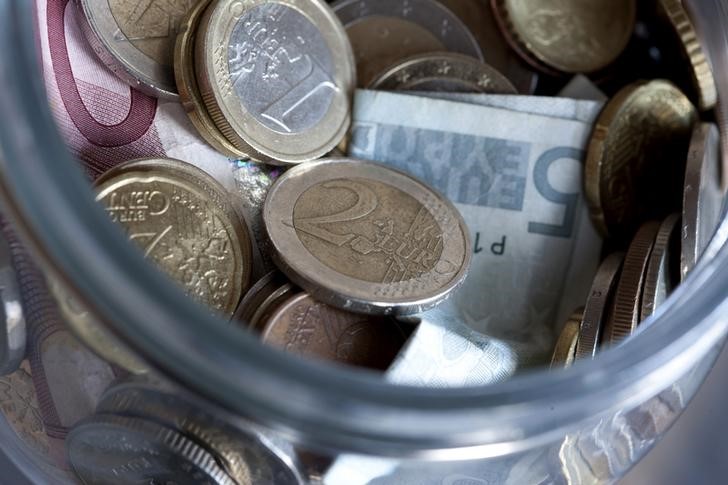By Mike Dolan
LONDON (Reuters) - Almost a quarter of this week's inaugural European Union recovery fund bond sale went to foreign central banks - and yet the euro's gradual rebound as a world reserve currency still has many doubters.
Ten years after an existential debt crisis rocked the bloc and undermined the euro's position in reserve coffers, the arrival of post-pandemic EU-wide bonds for investing in the future has for many observers drawn a line under the decade.
Reserve managers and sovereign funds, it's been hoped, will now move beyond the residual political and credit risks seeded by the 2010-2012 debt crisis and some $1 trillion worth of new EU-backed bonds will finally ease worries about scarcity, illiquidity and negative yields in underlying government bonds.
Critically for many reserve managers still seeking to make their allocations of debt more compliant with Environmental, Social and Governance (ESG) standards, a third of EU bonds issued over the next five years will be so-called 'green bonds' earmarked for climate protection projects.
"Reserve managers who want to diversify away from the U.S. dollar and also integrate environmental, social and governance strategies may welcome a large increase in the stock of jointly issued, and green, euro-denominated supranational assets," BNY Mellon (NYSE:BK) strategist Geoffrey Yu said of the programme.
So far, so good. A breakdown of bond buyers for the first 20 billion euros the EU's 800 billion euro 'Next Generation' funding this week showed 23% were central banks. That's slightly above the 21% who bought the 90 billion euros of debt backing the EU's job support programme SURE over the past six months.
The take up is encouraging with another 780 billion euros of the AAA-rated bonds to go - and this week's initial target of 10 billion euros of 10-year bonds meeting 142 billion euros of bids, eventually doubling the size of the sale.
With the European Central Bank showing no sign yet of easing up purchases of euro government bonds as part of its emergency monetary easing programme, the arrival of new top-rated bonds with a 20 basis point premium on Germany also starts to address a serious drought of paper for managers needing to hold euros.
DRIFT FROM DOLLARS
According to International Monetary Fund data, the drift away from U.S. dollars as the overwhelmingly dominant world reserve currency has continued through the past turbulent year of the pandemic.
Although exaggerated somewhat by foreign exchange and asset market valuation effects, the dollar's share of central bank reserves - at least where detailed breakdowns are available - fell below 60% at the end of last year for the first time since the IMF started compiling the so-called COFER data in 1999.
It was as high as 72% as the euro was launched in 1999 and 66% just six years ago.
The euro's share, on the other hand, popped above 21% in 2020 for the first time in six years - albeit still well shy of 28% peaks seen just before the euro crisis 10 years ago.
So, with those trends already underway and central banks keen to soak up the new EU bonds, the stage would appear to be set for a major rebalancing.
The number of countries with exchange rates explicitly tied to the dollar has been falling steadily for a decade, according to IMF data, while those tracking the euro stayed broadly stable. The share of imports from the euro zone to the major reserve holders and the share of external emerging market debt denominated in euros has also been rising.
Add growing geopolitical tensions between the United States and rivals such as China and Russia - and explicit warnings by those two and others of Washington's use of financial sanctions and the dollar to pressure them politically - and the prospect of some degree of "de-dollarisation" becomes a reality.
Just this month, Russia said it would ditch all dollar assets in its National Wealth Fund - some $40 billion worth - in favour of euros, Chinese yuan and gold.
NOT SO FAST
But not so fast on the euro at least, reckons Bank of America (NYSE:BAC), which this week published a deep dive into reserve currency shifts.
The report pointed out that the small euro reserve build over recent years was only marginally beyond simple valuation effects and this reflected the fact that parking euros in government debt generally is still dogged by negative yields, unfavourable relative yield comparisons and liquidity.
It pointed out that only 20% of AAA-rated bonds in the BofA ICE (NYSE:ICE) Euro broad market index currently had positive yields at all and the free float of these bonds was scarce.
The EU Next Generation bonds and their green bond component should help, it said, citing Bank for International Settlements surveys showing two thirds of central banks had yet to include sustainability targets in their reserve management and as many said there was scope to do so.
But they still yield close to zero and with the ECB bond buying likely to go on for another two years, the net sale of EU bonds will barely compensate for the shortage created in underlying government and government-linked debt.
"Reserve managers may also need to believe in the permanence of these bonds over a very extended horizon - possibly beyond the end of the recovery Fund in 2058," BofA concluded, adding the United States would likely catch up in green finance in the interim.
(By Mike Dolan, Twitter: @reutersMikeD; Editing by Edmund Blair)
